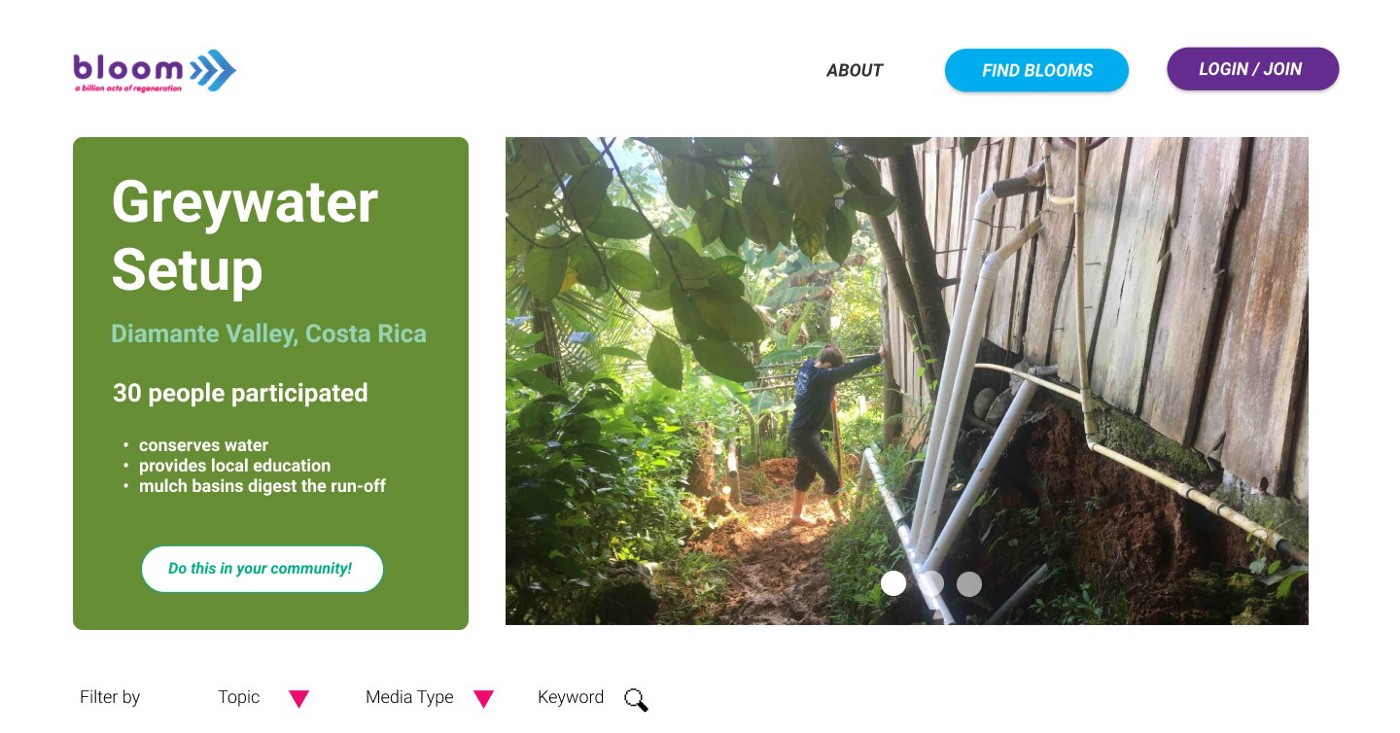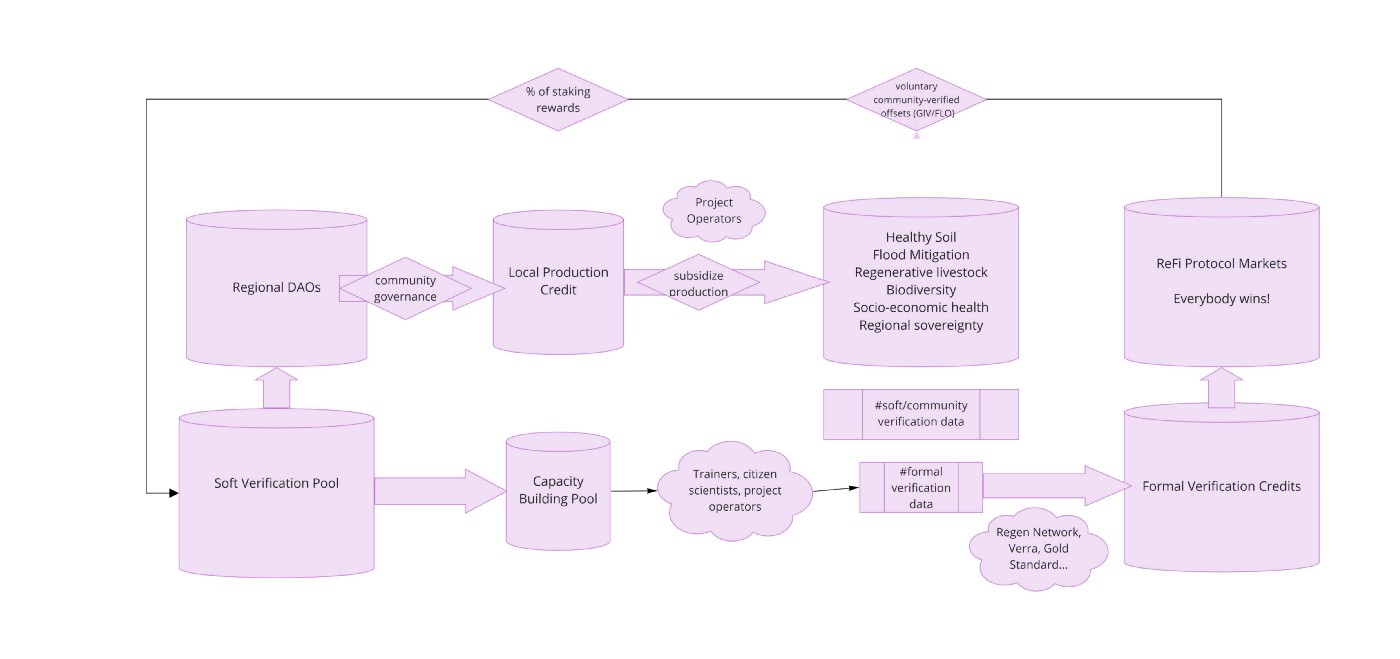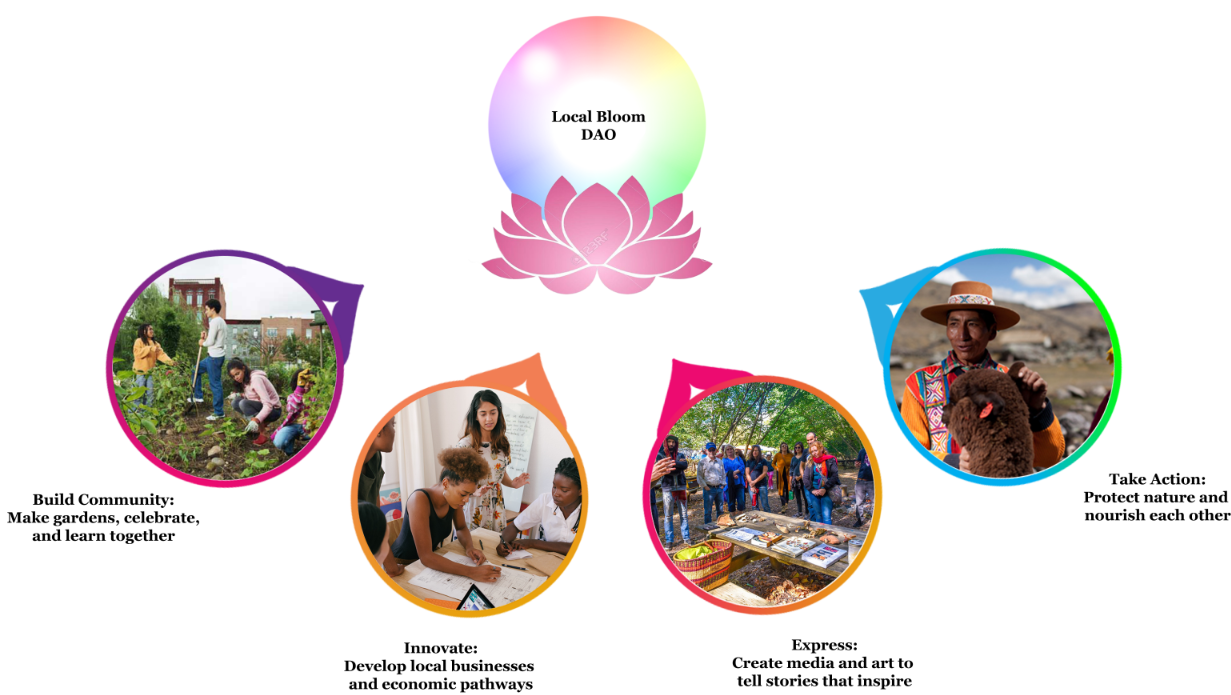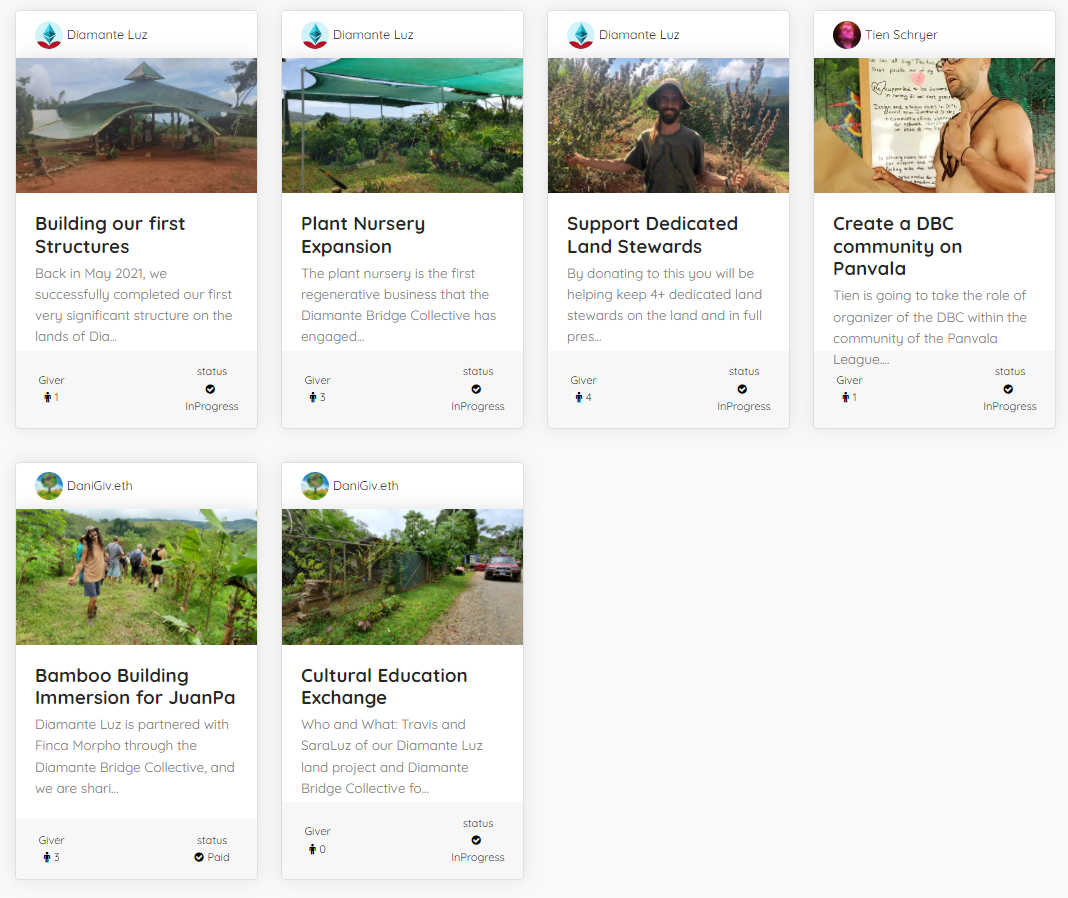ReFi and the Role of the Grassroots
This article is about how to connect grassroots climate/social action groups with ReFi markets. Tens of thousands of active grassroots IRL projects need web3 to be financeable. I believe this is the quickest path to addressing the climate crisis.
There is a subtext here about the deeper layers of market dynamics and culture that are integral to the new economies humanity needs, that perhaps do not fit into tidy boxes of carbon and biodiversity, but are fundamental. I make suggestions for how to structurally include them.
What is ReFi?
ReFi stands for regenerative finance. It’s an evolution of DeFi, or decentralized finance.
(However, you’d be surprised how many DeFi protocol founders built their infrastructure so
that it could be used for ReFi!)
ReFi is about aligning economic incentives to support behavior changes and have those changes
be rewarded. Tokens are used to represent assets such as a ton of carbon drawdown, or other verified
responsible land stewardship practices. ReFi protocols such as Toucan or Moss are designed to
drive up the price of carbon so that companies are economically incentivized to reduce emissions,
not just purchase offsets.
“We don’t value clean air and clean water, we leave it as something to clean up to the
nonprofits or government or otherwise.”
— Dave Fortson, Regen Network
ReFi allows people to create voluntary markets around the true value of ecosystems. At the end
of this article is a list of podcast episodes featuring ReFi protocol creators describing the
tech. How might grassroots groups, who represent a massive reserve of people power to care for
clean air and water, participate in these emerging protocols?
Grassroots groups are well positioned to rapidly address the climate crisis
Grassroots groups all over the planet have large networks of people ready to mobilize around
climate.
Here is a small set of projects that are happening:
- One Earth
- Explorer.land
- Indigenous-led water care groups
- Local Bloom Hubs are regional coalition DAOs that bring together different groups and movements to collaborate and share resources. Our local organizers are tapped into who is doing what in their region.
- Buckminster Fuller Institute and Lush Spring Prize
- La Via Campesina and community forestry movements
These groups are already here. They have developed proven interventions that work. Their solutions
can be (appropriately) replicated and scaled. They can move fast because they have no red tape,
organize by peer-to-peer mobilization, and there are millions of people in them. They are across
the board drastically underfunded, while being one of the biggest leverage points humanity has
right now. In tandem with ReFi, together we can incentivize the coordination labor that millions
of people want to spend more time doing.
Here are a couple key impacts grassroots typically achieve:
- Economic sovereignty as crucial measurement of successful ReFi applications
- Cultural knowledge, arts, relationships, security to support each other

Keyblade, by Chel Faust. Prints available
here.
Regenerative Ecosystem Projects
There is a second type of project similar to grassroots but more centralized in its
structure to accept funding. However, its time horizon to demonstrate impact and generate
revenue is longer than banking infrastructure can tolerate, hence these projects struggle to
access startup capital. Here are a few examples of that:
- Regenerative Resources’ mangrove reforestation approach creates healthy livelihoods for local communities to buffer stormwater surges, sequester carbon, increase biodiversity, and it jumpstarts several layers of cash crop aquaculture. Neal’s one my heroes and this project is starting to gain financial traction now after decades of legwork.
- Andean Pastoral Livelihood Initiative is a project of Regeneración Ecosistemas Perú. Mauricio Nuñez Oporto tells a beautiful story about listening to the Indigenous alpaca farmers describe their relationship with the alpaca, its spirit, and how they travel together in a deep regenerative relationship with nutrient cycling and the magic of life. One of their current asks is simply for buyers of their wool supply, because they don’t have direct connections with the fashion industry. The registries section below touches on regenerative market dynamics.
- Broadfield Permaculture Enterprises in Kampala, Uganda, is a local Bloom chapter. They have many active projects, farmers, training in schools, and farm cooperative formations. Charles has a tour planned to travel across Africa to collect seeds of native trees thought to be extinct. Their farming approach uses cash crops like coffee, bananas, and vanilla, interspersed with 500 indigenous plants to restore microclimate, soil health and provide livelihood at scale. He has robust data collection methods, is a former IT professional, and could easily adopt sensor tech. If someone from the carbon credit verification approaches could contact me and help get Broadfield set up on that, we would be grateful! And send you coffee :).
ReFi could create resource pools to support the scientific and financial costs of these types of projects to get verified.
These types of projects are at a larger scale than grassroots projects which take more of a “highly distributed smaller scale” approach. Both need support to come online to carbon/token economies.
The support grassroots groups need to be able to participate
The challenge here is that grassroots groups do not currently have data collection capacity nor
the startup capital necessary to mesh with formal carbon accreditation systems. They tend to
be made up of working class people and frontline communities doing survival action outside of
their dayjobs. They tend to be decentralized and not form the kind of core teams that mesh with
NGO or investment funding. They would need outside support to meet verification methodologies.
There are two main routes around this: creating practiced-based methodologies that can be verified,
and utilizing regional DAOs or other trusted hub networks to confirm regenerative action.
Regen Network is
doing fantastic work in this area. Their Science Team recently did a deep dive on how to
verify and support community-based approaches to environmental stewardship, with 40 new
methodology pathways. They acknowledge the value of knowledge sharing, marketing, and
holistic approaches. And they make it easier to incentivize small scale community practices.
(Those are very important when it comes to the deeper underlying colonial/extractive
economic power dynamics that are moreso the root of the issue with climate
destabilization.)
They have pilots in motion with Indigenous communities. People can create new methodologies as
well. I’m currently digesting their recent videos, linked at the bottom of this essay. Verra,
one of the main carbon credit standards, also has a
new methodologies approval process, albeit with a higher capital bar to entry.
Another finance option is to create a pool for capacity building, to support operators’ time
to learn how to verify their impacts, and to connect them with data and tech professionals. (See
Neal Spackman’s piece about
The Valley of Death in funding regenerative projects.)
I believe the fastest route to connect ReFi to groups on the ground will be something akin to
a community validation pool, with regional DAOs as validators. More on this in a bit. Nearly
all groups have at least one person who is willing and able to learn ReFi tech.
One thing to note is the small distributed scale of grassroots projects. These are not grasslands
scale farms, or large tree planting plots. They’re many small communities building high density,
small geographic footprint, high impact work. Many people doing regeneration work have access
to only small plots of land. I question whether formal accreditation is going to make sense for
these people. However, regional markets are fundamental to economic sovereignty and climate repair.
In the “pools” section below you will find a diagram of how to subsidize this scale of activity.
It’s important to incentivize large numbers of small projects to mesh with ReFi credits. Employing
these folks on
larger scale projects
could be wise so they can unplug from extractive industry jobs. Lastly, projects like
ACRE DAOs
or
Bloom’s cooperative incubator approach
are organizing to create web3 based business models that work to circulate finances and materials
regionally.
Altogether, these approaches can bridge the capital gap to unleashing the power of millions of
people taking direct IRL action for ecological and cultural regeneration.
My puzzled query aside, over how carbon and biodiversity verification might work or not for grassroots
groups, I have spent the past 15 years working out the financial plumbing for how to make these
groups’ work economically feasible. Here are some specifications that I’m working on with teams!
Bounties, impact dashboard, registries, and regional DAOs.
Moar fun!
 ETHDenver’s Bufficorn
ETHDenver’s Bufficorn
I am bullish on bounties for supporting grassroots organizers, and anyone wanting to do labor
to regenerate earth, drawdown carbon, and make more equitable societies. Bounties are a way to
incentivize participation at scale, to do actions that are known to reliably further regeneration.
Through my involvement with
Bloom Network
since 2010, I know there are millions of people who would do impactful contributions to movement
work if they were able to receive a stipend for their time. (Additionally, they would spend less
time doing keyboard activism in echo chambers like Facebook and Instagram. Separate rant I will
spare you.)
Examples of actions that have known impacts and are replicable at scale include: planting urban
food forests, installing greywater filtration and composting toilets (water conservation), suburban
soil sponge restoration (flood mitigation), training people to do transformative justice, etc.
We would need a little support to get impact metrics on those up to the level of major validators.
Millions of people doing regenerative actions at scale, if financially incentivized to do so,
would be the fastest pathway to achieving carbon drawdown, and it would fix the underlying economic
plumbing issue that is more of the problem.
The technology exists to run bounties programs at scale. A few years ago Bounties Network ran
a pilot with giving ETH to people who planted trees and did waterway cleanups. They simply had
people text a number using an SMS phone, and upload a photo of their action. Additionally, if
they held onto their ETH for a certain period of time, their community would receive an additional
dispersal of ETH. (source,
Simona Pop)
I envision the funding for these bounties to mesh with specific credit markets (land stewardship,
carbon drawdown, ESG-related projects).
Dashboards

Regenerative actions ticker. Concept by Tony Damico
of Long Beach Fresh.
Bloom bounties incentivize people to do regenerative actions and publish action templates that
anyone can use for inspiration/guidance. Members report an action they’ve done, using a simple
form and image verification upload on our website. These actions display on a ticker, showing
the impacts of the action, how many people participated, and how many tokens were distributed.
Ideally, I’d like to evolve the following infrastructure:
- It’s a widget that any community can embed on their website.
- A shared backend data infrastructure allows any community to display the relevant data sets of the impacts/actions they want to see.
- Feeds into a projects database (described more in the registries section below)
- Different dashboards that support large-scale coordination.
Bloom uses
MyMeta profiles
by MetaGame, so members can participate in other networks’ bounties programs and coordination
initiatives.
A percentage of Bloom’s DAO treasury will go toward rewarding these actions, and I’d like to
supplement that with ReFi pools where possible.
“I’ve tried to onboard my movement organizer friends to web3, and they’re not adopting
the tech.”
So don’t make them. The above approach is a minimal tech onboarding ramp, with simple form input
and regional validation. Once they want to claim funds or create a profile, they have to learn
the next step of connect wallet. Further, Bloom can host cryptoparties IRL to teach this in a
fun way.
Registries
One piece of infrastructure that will support both medium scale and grassroots regenerative
projects, are registries with sophisticated data structures. These would differ from carbon
registries of projects meeting the existing standards like Verra and Gold Standard, and
include projects at earlier stages of development. This would bridge the time horizon where
projects are building capacity to meet more hard data-intensive standards.
It would also help general purpose investment matching. In 2019 I spoke with a fund employee
whose job was to qualify leads. He said if there was an AI system to do that, including right
matches for investment thesis, he and everyone else who does his job in other firms would be
ecstatic.
Recommended tech stack:
- Ocean protocol or similar
- The cooperative data ownership models that Data Union have developed. Allows groups who contribute data to benefit from any sales related to the data. They have autonomy to choose license sets for who can access their data. Dataunion has capacity to run AI through the data sets.
- MyMeta profiles (built on Ceramic) for finding available talent
 Sample columns
Sample columns
In conclusion, project/funder registries would go a long way toward cross-network coordination
lubrication.
Pools
To address the gap in funding and scientific capacity among grassroots groups regenerating
soil, water, and societal relationships, I believe we can utilize voluntary credit pools
that lean into the strength of these knowledge keepers, to maximally speed up planetary
regeneration. Here are a few potential types:
- Soft verification pools — something similar to “bottom of the barrel” carbon credits, but coming from an opposite direction — highly impactful but hard to verify. A “soft verification pool” could allocate financing and other kinds of resources to these projects. It could incentivize community members from ReFi protocols or regional validators to train these projects on how to use the tools, and help them obtain any sensors or apps they need. These would likely work by flowing a percentage of staking rewards into a pool, with multistakeholder or programmed governance to distribute it.
- Local production credit — for regenerative production approaches whose unit economics can’t yet compete with industrial scale production and the subsidies that prop it up. Example: local clothing produced with fibers and natural dyes sourced from the regional watershed. The labor cost of small-scale sewing is high, but I believe it could be subsidized by voluntary local production credits coming from regional DAOs who have financing from carbon and biodiversity markets. Then everyone could have luxurious healthy biodegradable clothes that feel nice and are dyed with happy herbs and fungi. I wish this for you, anon. Also we’d have more sheeps. They are cute. P.S. you can graze sheep under solar panels and get layered economic returns on land.
- pool, for regenerative projects that are in the process of training up on sensor tech or writing measurement methodologies. Local scientists would probably be thrilled to participate.
- Token pools between communities. For example, we will be creating a GIV/FLO pool between Giveth and Bloom Network.
 Ways to subsidize the onboarding of projects onto formal ReFi markets
Ways to subsidize the onboarding of projects onto formal ReFi markets It’s not easy to break the tech down to a non-technical person, but there will be enough
tech savvy people in regional DAOs who do have good communication capacity, patience, and
relational context. Bloom can train people on how to use crypto tools, through IRL cryptoparties.
Voluntary carbon credit markets have more leeway than large-scale corporations to accept projects
as verified who have the opposite problem as the “scraping the smoke stacks” credits. Protocol-organized
pools for grassroots and early stage projects will be mutually beneficial.
If you are interested in exploring this farther with me, please
get in touch.
Regional DAOs

Regional DAOs are another approach to validating grassroots scale projects as well as more centralized
regenerative projects that are early-stage and have minimal financing. These are similar to
Olli Tiainen’s DIOs
(decentralized impact organizations).
The challenge they solve is that verifying impact in grassroots community projects is difficult
at this time. These projects tend to not have a centralized team nor funds to dock with verification
standards. In order to plug these folks into the ReFi infrastructure, I believe the best pathway
is to use regional DAOs or other vetting institutions who do have centralized capacity.
Examples:
- Regenerosity, a collaboration between Buckminster Fuller Institute and Lush Cosmetics, has vetted hundreds of holistically regenerative projects through each of their prize programs and other organizations’ prizes. They have a fantastic spreadsheet setup of a data structure for project-funders matching, including information such as scale, impact area, and more details.
- Indigenous communities
- Joe Brewers’ Earth Regenerators is another example of a network that could regionally verify impact contributions.
- Bloom Network has a steep bar for vetting new local Bloom hubs which become their own DAOs. They are close to their local context, and able to ascertain among themselves what are the most regeneratively impactful activities they can do for their bioregion and watershed health. They have IRL relationships with each other, and are able to verify actions logged via Bloom Network.
One power of IRL validating is the “go and see it” approach. Regeneration, in the deep
ecological, social, community and economic sense of it, is difficult for mainstream funders
to understand. It’s not single-issue, and it’s not always easy to measure in terms of impact
metric verticals.
During a funder training call with Regenerosity, one funder described his experience of visiting
a regenerative farm in Africa (I’m sorry I don’t remember specifically where!). He described
stepping in a maize field of the kind of imported destructive agriculture practiced there.
It was blazing hot, and dry, and forlorn feeling. And then the next field over was a
regenerative farm. There were multiple plants interspersed to capture different levels of
light and cycle nutrients. It was cooler, moist, and full of life.
And that’s when he understood the impact this farm was having and he decided to fund it. But
up until that point, remotely communicating, he did not get it.
We need to reward people who are actively doing regeneration at same time as we build data capacity
with them. The best way to validate these kinds of projects right now is through trust networks
that can vet and vouch for the projects’ impact.
If any Re-Fi protocol is amenable to accepting a regional DAO validator approach as a
standard of impact verification, please let me know, thank you!
It may be that my next step is to simply apply for an ecosystem grant from Regen Network or Cosmos
to create a verification methodology. It may also behoove us ReFi DAO folks to form a capacity-building
squad that can travel and train up IRL project leaders.
Resource: Bloom’s Five Qualities for Building Regenerative Relationships, drafted by Mansi Kakkar and Magenta Ceiba.
Indigenous Communities
Indigenous communities can be trusted to disperse resources wisely.
Caveat: I’m a European-ancestry settler living in the U.S, not an Indigenous person. These insights
are from speaking with
Atossa Soltani,
director of global strategy of Amazon Sacred Headwaters Initiative, hearing video
transmissions from
UMIYAC
via my work with
Femtheogen, and
talking with people who regularly travel to Shipibo communities.
In rural forest communities, regional DAO governance structures could help protect from land
destruction / land grabs, as well as boost communities’ ability to economically thrive so that
young people do not feel they have to leave to a city for opportunities.
One concern is that as carbon market prices go up, land prices will go up, centralized carbon
farming projects will move in, and Indigenous peoples will be displaced or continue to not be
compensated by their centuries of wise biodiversity cultivation. This is the #1 critical thing
to help not happen imho. It needs to be taken into account with how we build the protocols and
pools.
ReFi DAO is actively seeking
Indigenous land stewards, to support their initiatives.
Atossa had asked me for more information about DAOs for finance and governance power, but I’ve
been waiting until I know the right contacts to connect her with about it.
Fran Lambrick has
done community forestry organizing in Cambodia and is an example of a kind of contact who
may be able to advise on this concern. Here is a
video
of her describing the murder of her activist friend, Chut Wutty.
“I want to see people live with freedom, to have their culture, their traditions, to be
able to pursue their own lifestyle.” - Chut Wutty
Here is a video of UMIYAC (Union of Indigenous Yagé Medics of the Columbian Amazon). They describe
the murder of over a hundred of their community defenders per year. They call to protect Mother
Nature which is the life of all living beings, and describe the risk of extinction of the original
Indigenous nations of the whole Amazon.
ReFi protocols can direct funds to trusted Indigenous-led groups:
- Simply as a biodiversity credit for protecting their lands by living the way they do
- With additional multiplier for historical adjustment of genocide done to them by colonial systems
- In some cases with more formally verified carbon credits the way that Regen Network has piloted.
I think that could be a good defense strategy.
Deforestation Buffer Zones
It looks to me like
Rewilder
and
Sistema Natus
are supporting rewilding in zones at the edge of deforestation. When local people neighboring
Indigenous territories feel economically pressured to clearcut forest, if a DAO had robust economic
financing, they could instead teach those people how to grow higher value food crops that build
healthy forest, soil, and diet, rather than destroy it.
Bloom Network is going to be set up well to provide market demand. A local Bloom in Rio de Janeiro,
Muda Outras Economias,
has also innovated beautiful regional economy and ecological-spiritual regeneration pathways
using a token they created called Muda, which means seedling and also change in Portuguese.
One of their focus areas is organic farming in the land between cities and rainforest, which
provides a regenerative buffer for protection and reforestation.
>Native Jurisprudence
Lastly, Susanna Choe is convening a coalition with Indigenous rights of nature law leaders. That
could be another example of a trusted vessel for responsibly placing carbon and biodiversity
funds.
RELAW
(Revitalizing Indigenous Law for Land, Air and Water) is an Indigenous jurisprudence coalition.
In summary
It will take time to upskill existing grassroots groups to collect the kind of data needed
for verification. In the meantime, it behooves everyone to empower these groups during that
process.
My hunch is we may need to implement some voluntary fund pools that don’t have full carbon credit
verification yet, in order to mitigate the risk of encroaching on Indigenous territory, and to
best utilize the existing capacity for rapid scale among grassroots action groups. These might
use community validator nodes (regional hubs, trusted vetting organizations) and transparent
distribution of funds.
Meanwhile, we can train up people willing to learn the technology, and also learn from them how
they measure ecosystem regeneration.
Regenerative Economic Protocol
I have drafted a list of Regenerative Actions from 13 years of R&D across local Bloom
chapters in 11 countries. They are actions that are known to improve climate conditions,
quality of life, economic equity and justice, etc.
I’ve been researching the ReFi protocols that are emerging, and it seems that this regenerative
economic protocol is still needed, to incentivize the types of actions that work on the deeper
layers of restoring healthy fabrics of relationships. Those that are excluded by, and historically
destroyed by, colonial systems of power control.
The way I envision this being feasible is through the pools described above, and a token trading/transform
structure that represents local, project-based, and international protocols.
Once Bloom completes our legal formation and token setup, we will create a pool with Giveth,
GIV/FLO. Through Giveth we are already able to distribute tokens to local Bloom projects, for
example
Diamante Bridge Collective
uses Giveth Trace. Projects upload verification of milestone completion, which is required before
funds are dispersed to contributors. (Shoutout to
Danielle
Gennety who has been my sister in living on gift economy giving everything she has to planetary
ecosystem well-being.) I’d love to see Bloom connect with other ReFi protocols as well! Please
feel welcome to
get in touch.
 I initially came to web3 because I ran into a brick wall with financing Bloom because its
DAO structure and all these grassroots projects did not mesh with any centralized finance
institutional funding pathways. In looking at Commons Stack
and
BlockScience, it
seemed to me that some kind of pool infrastructure would be a way to dock with university
and government funding, in order to start to transfer money, resources, and power away
from centralized gatekeeper colonial old world institutions that are slow-moving and have
problematic incentive structures, into the faster moving grassroots.
I initially came to web3 because I ran into a brick wall with financing Bloom because its
DAO structure and all these grassroots projects did not mesh with any centralized finance
institutional funding pathways. In looking at Commons Stack
and
BlockScience, it
seemed to me that some kind of pool infrastructure would be a way to dock with university
and government funding, in order to start to transfer money, resources, and power away
from centralized gatekeeper colonial old world institutions that are slow-moving and have
problematic incentive structures, into the faster moving grassroots.
My question for all you protocol developers: Would you be willing to connect a pool of funds
from the staking rewards to “community validator hubs”, who are actively upskilling but not yet
able to get the hard data to plug into the major standards? Is that already happening, and if
so, where?
The wiring I’ve described throughout this essay will help ensure progress and inclusion along
the many-small-acts axis of climate repair. While we force corporations to reduce emissions,
we simultaneously nurture the communities-based approach to regenerative economies.
Blockchain is built to redistribute financial power, and the ecosystem is now mature enough to
be able to interface with non-technical doers of climate actions. No other financial or organizational
infrastructure on the planet can do this in time.
Dangers to Avoid
- Orgs and impact entrepreneurs displace Indigenous people, and absorb $ that should instead be led by local communities and their paradigms
- Grassroots marginalized groups continue to be unable to access funding in a web3 context, because they don’t have capacity to log data, fundraise, and interface with tech
- Frontline land protectors continue to be murdered
- Stuck in the same vertical results-based finance paradigm - **whose knowledge set** has power?
Asks
Contact: Twitter dm
- If you are a ReFi protocol developer, would you be open to utilizing any of the pools I describe above?
- Would you like to help make a regenerative economic protocol with me, to connect the infrastructure described here with mainstream impact markets?
- Is there a working group on verification methodologies I can join?
- Contribute funding to Bloom Network via Gitcoin and Giveth (GIVback returns of 75%)
- Help local groups dock with ecosystem credits, by teaching them how to record the data your protocol needs for validation. Ideally this should come with financing for their time, since it will take their time away from real farming and coordinating projects directly. There are 4 local Blooms that are mature enough to participate now.
- Soon the official Call to Bloom will begin. At that time you’ll be able to join our cooperative/DAO, and we’ll invite more people to start local Blooms to nurture regenerative cultures to permanence. You can help by connecting us with press opportunities, investors, or voicing interest in starting a local Bloom. Contact us here.
Lead with love,
Magenta
ECO (executive creative officer),
Bloom Network
Additional resources:
- Re-Fi with Dave Forsten, On the Block Explorer — great primer on what ReFi is, and also about what Regen Network does
- Toucan Protocol on the My Climate Journey Podcast
- List of regenerative culture podcasts from grassroots communities
- Bloom Podcast
- Giving (carbon) credit where it’s due — a detailed summary of current voluntary carbon credit markets
Videos from Regen Network’s Environmental Stewardship Methodology Retreat:
- Overview Presentation
- Environmental Stewardship Intro Presentation
- Environmental Stewardship Retreat Day 2 — Funding and Rewards
- Environmental Stewardship Retreat Day 3 — Methodologies and Legitimacy
- Environmental Stewardship Retreat Day 4 — Verification and Data Collection & Storage

